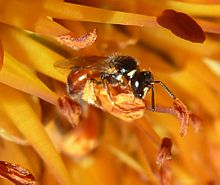| Allodapini | |
|---|---|

| |
| Allodapula sp. in South Africa | |
| Scientific classification | |
| Domain: | Eukaryota |
| Kingdom: | Animalia |
| Phylum: | Arthropoda |
| Class: | Insecta |
| Order: | Hymenoptera |
| Family: | Apidae |
| Subfamily: | Xylocopinae |
| Tribe: | Allodapini Cockerell, 1902 |
| Genera | |
|
Allodape | |
The Allodapini is a tribe of bees in the subfamily Xylocopinae, family Apidae. They occur throughout sub-Saharan Africa, South East Asia, and Australasia.[1] There is also a rare genus, Exoneuridia, that occurs in isolated regions of Turkey, Iraq, Lebanon and Iran.[2]
Many of the species in the tribe form small social colonies where a group of females cooperatively care for the developing larvae.[3] The larvae are fed on pollen which, like most other bees, is carried on specialised hairs of the hind pair of legs, but the pollen is fed to the larvae in a progressive fashion and usually placed directly onto their bodies where they then consume it.
The larvae of allodapine bees are remarkable in their complex morphology, and in most species they possess appendages, tubercles and long setae.[4] The strange morphology of allodapine larvae is probably a result of living in open tunnels where they are in constant contact with other larvae and with adults. The appendages, tubercles and setae serve to hold and manipulate food, and may also help larvae move around the nest. These abilities are important because larvae compete with each other to gain food, a situation which is different from all other bees, where individual larvae are isolated in cells and do not have to compete with each other.
There are over 300 described species of allodapine bees,[1] but many more species are undescribed. They are unique among bees in progressively rearing their larvae in undivided tunnels, so that individual larvae are not physically isolated from each other and are in constant contact with adult females, who provide them with food, groom them, and remove their faeces.[1]
Allodapine bees vary greatly in their forms of sociality, from subsocial to highly eusocial.[5] There are no known species that are purely solitary.[6] They have been used widely to study social evolution,[7] sex allocation,[8] social parasitism, and historical biogeography.[9]
- ^ a b c Michener, C.D. (2007), Bees of the World, Baltimore & London: Johns Hopkins University Press
- ^ Terzo, M. (1999). "Revision du genre Exoneuridia Cockerell, 1911". Belgian Journal of Entomology. 1: 137–152.
- ^ Michener, C.D. (1974), The Social Behavior of the Bees, Harvard University Press, pp. 307–309
- ^ Michener, C.D.; Syed, I.H. (1962), "Specific characters of the larvae and adults of Allodapula in the Australian region", Australian Journal of Entomology, 1 (1): 30–41, doi:10.1111/j.1440-6055.1962.tb00168.x, S2CID 83715378
- ^ Schwarz, M.P.; Richards, M.H.; Danforth, B.N. (2007). "Changing paradigms in insect social evolution: new insights from halictine and allodapine bees". Annual Review of Entomology. 52: 127–150. doi:10.1146/annurev.ento.51.110104.150950. hdl:2328/9446. PMID 16866635.
- ^ Chenoweth, L.B.; Tierney, S.M.; Smith, J.A.; Cooper, S.B.J. & Schwarz, M.P. (2007). "Social complexity and large colony sizes are not sufficient to explain lack of reversions to solitary living over long time-scales". BMC Evolutionary Biology. 7: 246. doi:10.1186/1471-2148-7-246. PMC 2231370. PMID 18154646.
- ^ Schwarz, M.P.; Tierney, S.M.; Rehan, S.M.; Chenoweth, L.B. & Cooper, S.B.J. (2007). "The evolution of eusociality in bees: Workers began by waiting". Biology Letters. 7 (2): 277–280. doi:10.1098/rsbl.2010.0757. PMC 3061166. PMID 20943679.
- ^ Thompson, S.; Schwarz, M.P. (2006). "Cooperative nesting and complex female biased sex allocation in a tropical allodapine bee". Biological Journal of the Linnean Society. 89 (2): 355–364. doi:10.1111/j.1095-8312.2006.00679.x.
- ^ Chenoweth, L.; Schwarz, M.P. (2011). "Historical biogeography of Australian allodapine bees". Journal of Biogeography. 38 (8): 1471–1483. doi:10.1111/j.1365-2699.2011.02488.x. S2CID 83205237.